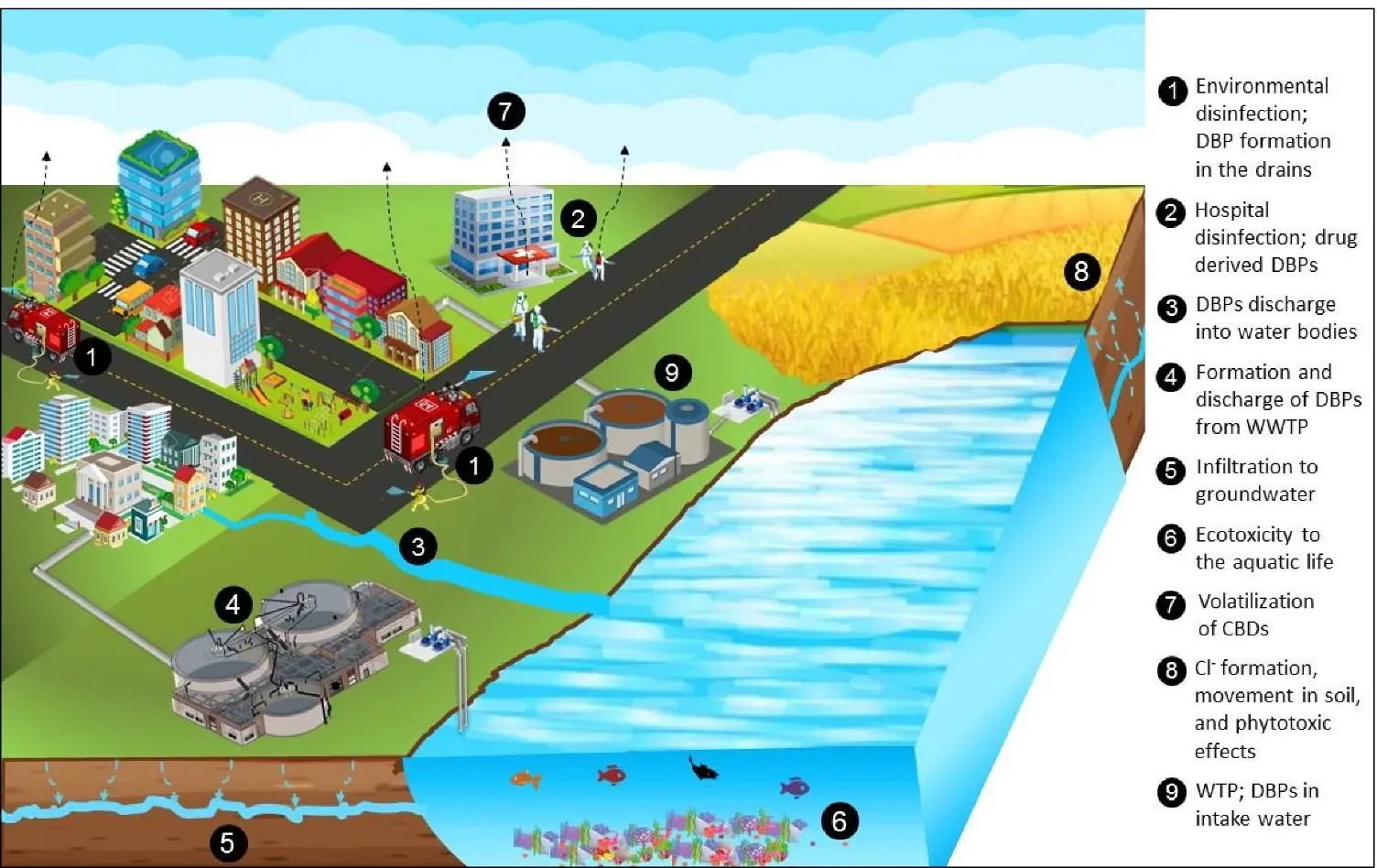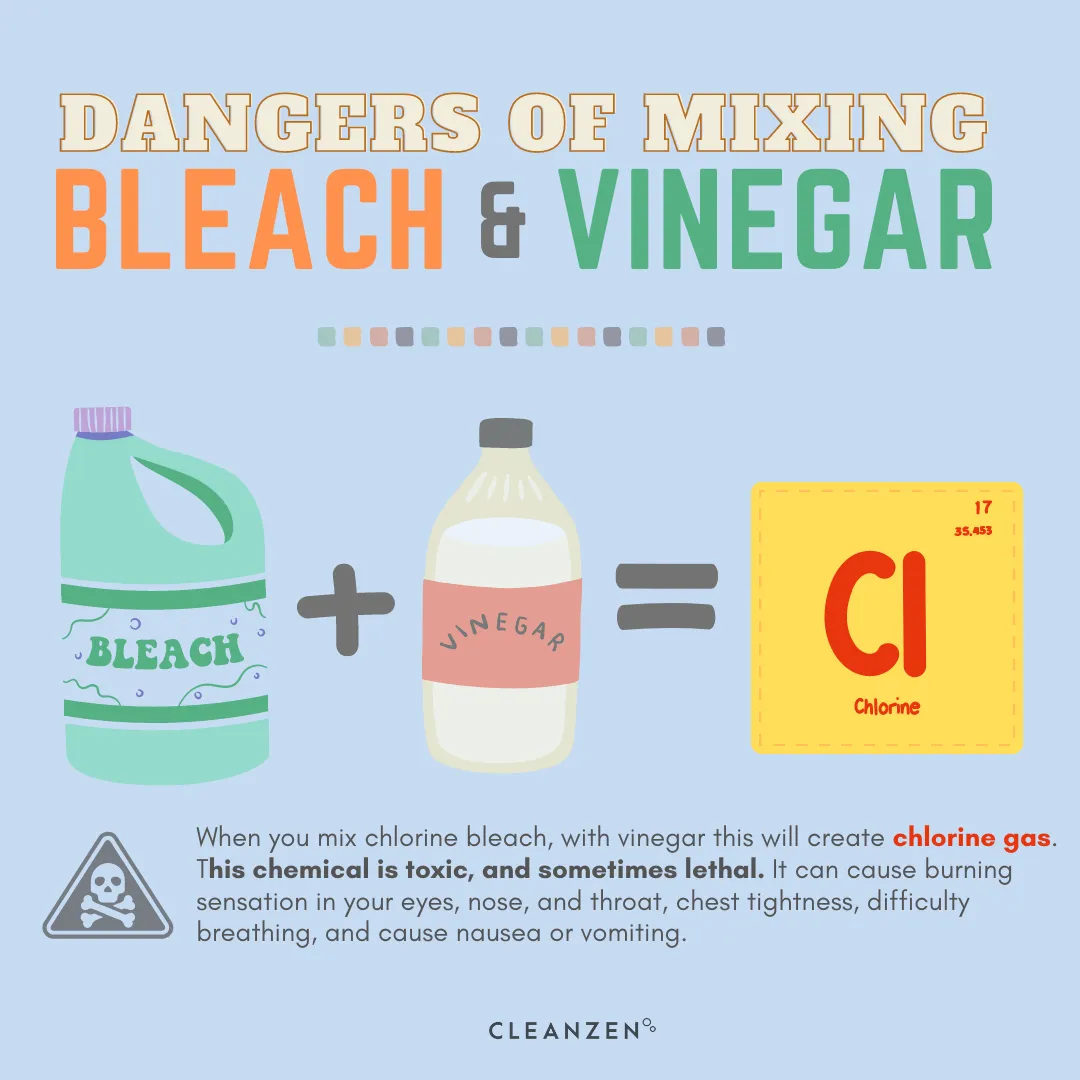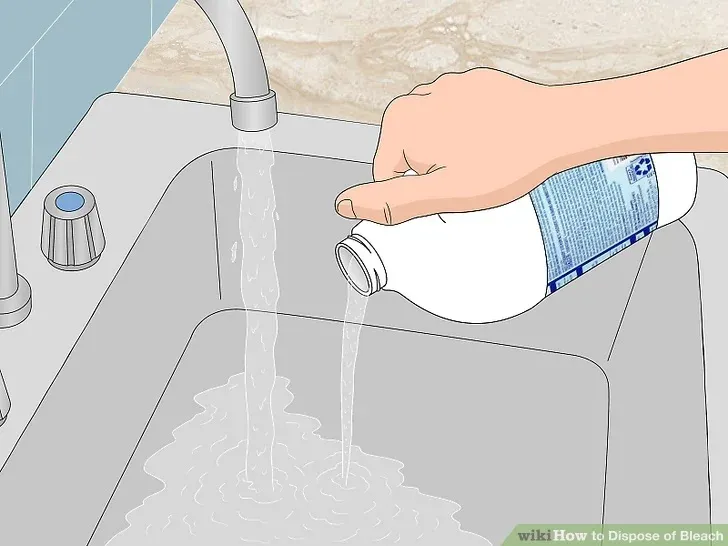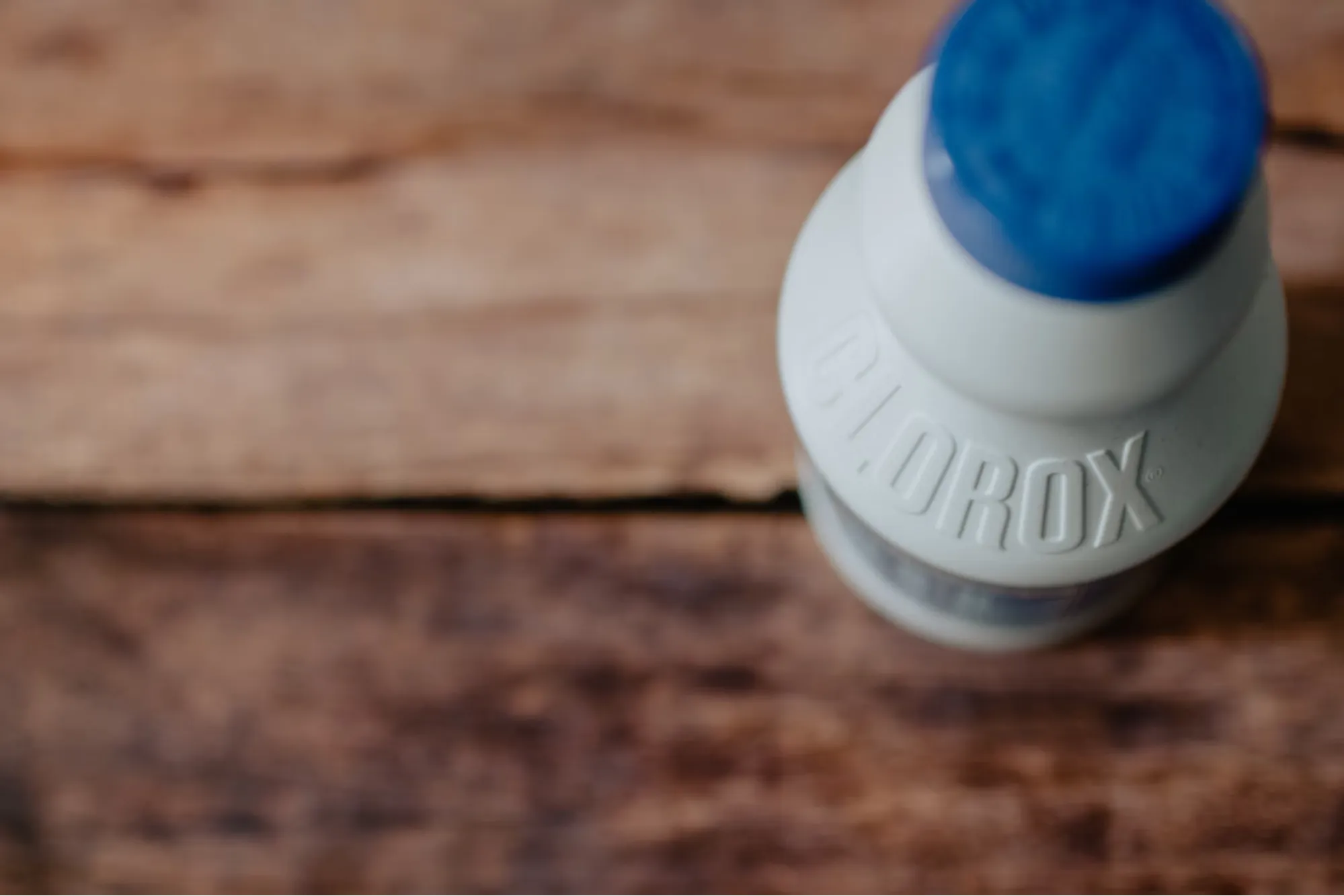Mastering How to Dispose of Bleach: A Comprehensive Guide for Responsible Handling
Time for trivia: name one chemical compound that can clean off mold, deodorize garbage bins, remove stains, sanitize floors, brighten white linens, and create a DIY disinfectant spray.
You’ve guessed it right. Bleach can do it all, and it makes it one of the most widely used chemicals in American households. This makes it important to know how to dispose of bleach properly.
Managing household hazardous waste is part of our mission at Jiffy Junk. This is why we encourage our clients to handle different types of waste responsibly. For example, we teach them how to dispose of cooking oil, motor oil, and other chemicals safely. Bleach is also on the list.
According to the EPA, materials that can catch fire, explode, or have corrosive and toxic properties are classified as hazardous. This includes car fluids such as antifreeze, motor oil, brake fluid, cleaners such as chlorine bleach, and drain cleaners.
Bleach represents a real hazard because it has so many common applications and people usually pour it down their drains when done. Unfortunately, the impact of these actions can be disastrous because bleach contains sodium hypochlorite, a potent oxidizing agent that can harm aquatic ecosystems.
Guilty? Don’t worry. If you have been disposing of bleach improperly, this article is for you. We will walk you through the process of how to dispose of bleach properly, highlighting the neutralization techniques, innovative methods, and legal considerations involved in bleach disposal.
Are you ready to learn a new way to reduce your carbon footprint?
Get a Live Quote Now
Connect to a live representative and get a quote in real time for junk removal in your area.Table of Contents
TL;DR
- Improper disposal of bleach has a serious impact on aquatic environments.
- Bleach affects wastewater management processes
- Proper neutralization minimizes the toxic properties of bleach and makes it safer to handle.
- New technologies are changing how we handle bleach and can reduce its toxicity.
- Different laws and regulations apply when residential and commercial spaces deal with bleach waste.
- Bleach containers have an upcycling potential and can be used for several projects to minimize your footprint.
- Using safe bleach alternatives is another option to reduce bleach waste.
Environmental Impact of Improper Bleach Disposal
Many people just don’t know how to get rid of different household chemicals like bleach. They simply dump it into the nearest waterbody or landfill, not knowing how this can have a lasting impact on the environment.
So, you’ve used some bleach for cleaning. Why don’t you just pour it in the toilet or sink? According to Homes and Gardens, bleach is one of the liquids that experts warn against pouring into drains because of its toxicity and ability to cause erosion.
At Jiffy Junk, we prioritize green practices. So, we teach our clients how to dispose of bleach safely without gaming different ecosystems. This aligns with our other environmental initiatives, as we’ve been taking part in the climate week by planting more than 15,000 trees since 2023.
Aquatic Ecosystem Disruption
You don’t have to literally dispose of bleach in a lake or pond to disrupt the ecosystem. When you pour it into your sink, this chemical eventually finds its way to rivers and oceans.
Improper bleach disposal disrupts aquatic ecosystems and makes wastewater treatment processes challenging. These processes aim to remove contaminants from wastewater, so it can be used for irrigation and other purposes. However, bleach combines with organic matter to form toxic chloramines in water bodies.
But that’s not all. Bleach also raises water pH and kills various aquatic organisms. It causes the rapid depletion of dissolved oxygen in water, killing fish, aquatic plants, and other aquatic animals.
Even if they don’t die, low concentrations of bleach can disrupt the endocrine systems of fish and amphibians, which affects their reproductive cycles
Algal Bloom Acceleration
The high chlorine content in bleach stimulates the excessive algae growth in water bodies. When they grow, algae can disrupt aquatic ecosystems as they affect oxygen levels. So, how does this happen?
Chlorine can eliminate algae-eating microorganisms, allowing certain algae species to proliferate. Moreover, bleach-induced changes in water chemistry can create favorable conditions for harmful algal blooms.
Algal blooms can lead to hypoxic "dead zones" in water bodies, devastating aquatic ecosystems. You’re literally suffocating aquatic life by disposing of bleach improperly.
Microorganism Decimation
When aquatic ecosystems are balanced, different species live in harmony. But bleach’s potent antimicrobial properties can decimate beneficial bacteria and microorganisms essential for maintaining this balance.
For, example, bleach can eliminate nitrogen-fixing bacteria, disrupting nutrient cycles in aquatic environments. Due to the loss of microbial diversity, water bodies become more susceptible to invasive species that harm different plants and animals. Bleach disposal affects food webs, which affects larger aquatic organisms.
Our Jiffy Junk eco-friendly practices are always a priority, so we offer comprehensive green solutions to minimize the amount of bleach ending up in water bodies. Our partners will transport leftover bleach containers to the nearest recycling facilities along with other types of junk to leave your space clean without harming the environment.

Learning how to dispose of bleach properly minimizes its negative impact on the environment.
Source: link.springer.com
Wastewater Treatment Challenges
As it enters sewage systems, bleach poses significant challenges for municipal water treatment processes. Bleach can inactivate beneficial bacteria used in biological wastewater treatment processes, thus making the process more challenging.
That’s not all. High levels of bleach can corrode pipes and equipment in wastewater treatment facilities. Additionally, the chemical reactions of bleach in sewage can produce harmful disinfection by-products, including trihalomethanes.
Chlorine Gas Formation
Bleach’s danger doesn’t stop at the water level. It interacts with other chemicals like ammonia in sewage systems to form the dangerous chlorine gas.
Acidic conditions in sewers can cause bleach to release chlorine gas, posing risks to workers in waste management facilities. Moreover, chlorine gas formation can lead to pressure buildup in closed sewer systems, risking explosions.
Biological Treatment Interference
Wastewater treatment plants rely on beneficial bacteria to remove waste and make waste usable. However, bleach disrupts the delicate balance of these bacteria and compromises the purification process.
Bleach can inhibit the growth of nitrifying bacteria, crucial for removing ammonia from wastewater, thus making the process unsuccessful.
Moreover, disruption of biological treatment can lead to increased levels of organic pollutants in effluent. Unfortunately, recovery of biological treatment processes after bleach exposure can take weeks or even months.
Here’s a summary of how bleach impacts wastewater treatment processes.
| Process Affected | Consequences |
|---|---|
| Nitrification | Reduced ammonia removal |
| Biological Oxygen Demand (BOD) removal | Increased organic pollutants in effluent |
| Sludge digestion | Slower breakdown of solids |
| Pipe integrity | Corrosion and potential leaks |
The Chemistry of Bleach Neutralization
Dealing with dangerous chemicals guarantees that they’re safe to handle and won’t harm the environment. This is why understanding the science behind bleach neutralization is crucial for the safe disposal of bleach.
Neutralization is a process that involves reducing the oxidizing power of hypochlorite ions in bleach to convert hypochlorite to chloride ions. These are much less reactive and won’t impact the environment in such a negative way.
Through neutralization, pH levels are adjusted because bleach becomes more unstable and reactive at lower pH levels.
Reducing Agents in Bleach Neutralization
The neutralization process of bleach relies on reducing agents that counteract bleach's oxidizing properties. They lend electrons to hypochlorite ions, converting them to chloride ions, which are more stable.
A reducing agent’s effectiveness depends on its standard reduction potential. However, not all reducing agents are the same. Some can release harmful by-products, so carefully choosing the right one is essential.
Sodium Thiosulfate as a Neutralizer
One of these agents is sodium thiosulfate. This is a powerful and widely used bleach neutralizer, which reacts with bleach to produce sodium chloride and sodium sulfate.
This reaction is rapid and complete. As a result, it’s ideal for emergency spill neutralization. Moreover, excess sodium thiosulfate doesn't pose significant environmental risks, unlike unneutralized bleach.
Vitamin C (Ascorbic Acid) Neutralization
Another agent is Vitamin C or ascorbic acid. It’s an effective and environmentally friendly bleach neutralizer that reduces hypochlorite to chloride while being oxidized to dehydroascorbic acid. This reaction is pH-dependent, with optimal neutralization occurring in slightly acidic conditions.
Vitamin C neutralization produces no harmful byproducts, making it safe for environmental disposal.
At Jiffy Junk, we educate clients to teach them how junk removal benefits the environment. This is why we always advocate for eco-friendly waste management processes, including disposing of bleach.
pH Adjustment Techniques
Typically household bleach solutions are alkaline and have high pH levels, so balancing these levels is essential for safe disposal. Most of these solutions have a pH level between 11 and 13, which can be harmful to aquatic environments.
As a result, the safe disposal of bleach focuses on bringing the pH to a neutral range between 6.5 and 8.5, before this solution is disposed of. Studies show that adjusting bleach to a neutral pH (7.0) can reduce its environmental impact by up to 90%.
However, this process should be done properly and slowly because rapid pH changes can cause chemical instability.
Vinegar as a pH Neutralizer
As a homeowner, you can safely neutralize bleach before you order our specialized decluttering services. Once neutralized and put into safe containers, our trained team will pick up leftover bleach and dispose of it properly, making sure that it doesn’t negatively impact the environment.
Vinegar is a common household item and some people suggest using it to neutralize bleach's high pH. Acetic acid in vinegar reacts with sodium hypochlorite to produce sodium acetate and hypochlorous acid. However, it’s not the safest option out there because it can release chlorine gas if not performed carefully.
This process only works if you have small quantities of diluted bleach solutions. Also, proper ventilation is essential.
If you’re dealing with large amounts of concentrated bleach, you should avoid this method. As a result, this method isn’t usually advisable.
Baking Soda for pH Stabilization
Another safer solution is using baking soda, another safe household item. Sodium bicarbonate in baking soda acts as a buffer, gradually lowering the pH of bleach solutions.
When you mix baking soda with bleach, the reaction produces sodium carbonate and sodium hypochlorite, which further decomposes over time.
This is the kind of treatment we recommend to all our Jiffy Junk clients as part of our junk removal tips.
The following table summarizes the different bleach neutralization methods.
| Method | Pros | Cons |
|---|---|---|
| Sodium Thiosulfate | Fast, complete neutralization | Requires precise measurements |
| Vitamin C | Environmentally friendly, safe | More expensive than other methods |
| Vinegar | Readily available, inexpensive | Risk of chlorine gas formation |
| Baking Soda | Safe, gradual pH adjustment | Slower neutralization process |

Mixing bleach with vinegar shouldn’t be part of your bleach disposal practice because it releases toxic fumes.
Source: cleanzen.com
Innovative Bleach Disposal Methods
Apart from these traditional methods, new technologies are reshaping how we dispose of bleach. They’re also changing how we handle waste and junk removal.
At Jiffy Junk, we collaborate with the country’s best recycling and waste management facilities to guarantee that your residential and commercial waste doesn’t negatively impact the environment. Moreover, we have employed AI technology to streamline our booking services.
So, how are new practices changing how we deal with bleach?
Recycling facilities rely on advanced oxidation processes to break down bleach into harmless components using radical reactions. Some methods combine multiple techniques, such as chemical reduction and photocatalysis to harness their benefits.
The purpose of these emerging technologies isn’t just to neutralize bleach but also to recover useful byproducts.
Photocatalytic Degradation
A new technology called photocatalytic degradation depends on the power of sunlight and catalysts to break bleach into harmless components. This process uses a green source of energy, which is light energy, to activate a catalyst, generating reactive species that degrade bleach.
The process can completely mineralize organic compounds in bleach, producing CO2 and water. Photocatalytic methods can be combined with solar technologies for energy-efficient bleach treatment.
Several waste management facilities are now improving how they handle different types of household waste. For example, the city of Denver now implements an innovative Household Hazardous Waste collection program to encourage people to dispose of waste responsibly.
Titanium Dioxide Nanoparticles
Another technology depends on titanium dioxide nanoparticles. These are showing great promise in accelerating bleach decomposition through photocatalysis.
TiO2 nanoparticles generate hydroxyl radicals when exposed to UV light, rapidly degrading bleach without harmful by-products. The small size of nanoparticles provides a large surface area, enhancing catalytic efficiency. This process is effective even in low light, making it versatile for various settings.
Electrochemical Treatment
Decomposing bleach allows waste management facilities to handle it without impacting the environment. Electromechanical methods can be used to achieve this by reducing hypochlorite to chloride ions without adding chemicals.
Adjusting the current density and electrode materials can affect the speed and potency of this process. Luckily, some electrochemical methods can simultaneously treat bleach and recover valuable chlorine compounds for the best results.
Electro-Fenton Process
The Electro-Fenton process combines electricity and iron catalysts to rapidly degrade bleach. This method generates hydroxyl radicals in situ, providing powerful oxidation of bleach components and making bleach safe to dispose of.
It can be enhanced by using air-diffusion cathodes to produce hydrogen peroxide. Most facilities use this method to treat high-strength bleach solutions resistant to conventional methods.
As a matter of fact, studies show that this is one of the safest ways to treat wastewater and remove contamination without harmful by-products.
Legal and Ethical Considerations in Bleach Disposal
Apart from the environmental consequences, there are several legal and ethical considerations to think about before disposing of bleach.
Since bleach is classified as hazardous waste, several compliance rules apply when you handle it. These laws vary between residential and industrial users and different jurisdictions.
Regulatory Compliance Across Jurisdictions
Bleach disposal regulations can vary widely between regions. According to the EPA, household hazardous waste, including bleach, is exempt from federal hazardous waste regulations if generated by normal household activities. However, that doesn't mean it should go down your drain.
Things are different for businesses generating bleach waste. These organizations fall under a different set of laws that govern how they should store, transport, and dispose of bleach at the designated facilities.
At Jiffy Junk, we understand that commercial and residential clients have different needs. This is why we offer different commercial junk removal services that can be tailored to meet your business needs. This includes storage unit cleaning services where you could be storing bleach for disposal.
Different jurisdictions could require dilution and pH neutralization before sewer disposal. Moreover, international shipments of bleach waste may be subject to Basel Convention regulations, which govern how hazardous waste is transported.
Industrial vs. Household Regulations
The legal frameworks governing bleach disposal differ significantly between commercial and residential users. In most cases, industrial users face stricter reporting and treatment requirements for bleach disposal. This is due to the amount produced and possible contamination.
For example, OSHA has specific guidelines that emphasize the safe handling and disposal of bleach to prevent worker exposure. Smaller amounts of diluted bleach can be treated as household waste.
On the other hand, household bleach disposal is governed by local wastewater treatment regulations. In Oregon, bleach shouldn’t be poured down drains because wastewater management facilities aren’t designed to handle it. Only a very small amount can be flushed down the toilet with plenty of water and only if it’s connected to the city sewer. Other states could follow different rules.

Disposing of bleach by pouring down the drain is prohibited in most states and leads to legal consequences.
Source:Wikihow.com
Corporate Social Responsibility in Bleach Disposal
Businesses can exceed legal requirements by implementing ethical bleach disposal practices. For example, some companies are adopting zero-liquid discharge systems to eliminate bleach waste entirely.
Corporate sustainability reports increasingly include metrics on chemical waste management. Ethical bleach disposal involves partnering with environmental organizations for proper handling.
This is where we come. At Jiffy Junk, we’re ready to cooperate with businesses and local organizations to keep the environment safe and dispose of waste without negatively impacting ecosystems.
We offer proper handling and transporting bleach to the designated facilities where it’s properly treated. Just enter your zip code and check our locations and you’ll find one of our experts who will be ready to help you dispose of bleach.
Bleach Recycling Initiatives
The waste and junk management industries are evolving and changing. As a result, innovative programs are emerging to repurpose or recycle bleach products, minimizing environmental impact.
Some facilities can recover and purify sodium hypochlorite from waste bleach solutions to produce usable bleach. Other bleach byproducts can be used in other industrial processes, creating a circular economy.
Moreover, bleach containers can be recycled into new plastic products through specialized processes.
Upcycling Bleach Containers: A Creative Approach
Apart from disposing of bleach itself, bleach containers also represent a solid recycling opportunity. Empty bleach bottles offer opportunities for creative repurposing, reducing waste, and promoting sustainability.
Some plastics used in bleach bottles are highly durable, making them suitable for long-term reuse. Upcycling can reduce the environmental impact of plastic waste associated with bleach packaging. However, proper cleaning of bleach containers is crucial before upcycling to remove all chemical residues.
Many people have no idea about the strange things that can be recycled instead of cluttering your home. But this is where we step in.
At Jiffy Junk, we offer comprehensive bulk junk removal to help you get rid of old bleach containers that occupy valuable space.
Artistic Transformations
Bleach containers can serve as raw materials for creative projects. The opaque nature of bleach bottles can be utilized for light-diffusing art installations.
Some artists use bleach bottle plastic for sculpture, taking advantage of its moldability when heated. Moreover, the durability of bleach container plastic makes it suitable for outdoor art projects.
This can be an interesting DIY project for the family. It also teaches your little ones about recycling.
Luminous Garden Planters
Before hiring one of our comprehensive cleaning services, such as basement cleanout, it’s important to evaluate the potential of empty bleach containers.
These bottles can be transformed into light-reflecting outdoor planters. The shape of bleach bottles provides good drainage when modified for planting. Additionally, the UV-resistant properties of bleach bottle plastic help planters withstand outdoor conditions.
Bleach bottles are typically opaque. However, reflective properties can be enhanced by adding metallic paint or reflective tape to the planters.
You’re basically turning junk into something valuable that provides value. It’s a good way to save some money too.
Eco-Friendly Bird Feeders
Instead of harming the environment, you can make your backyard more inviting to wildlife using discarded bleach containers. They can be transformed into bird feeders because the wide mouth of bleach bottles is ideal for creating accessible feeding ports for birds.
You can add perches and using food-safe coatings can enhance the functionality and safety of the feeder. However, proper sealing techniques are crucial to ensure the feeder remains waterproof.
Functional Household Items
Many people worry about the financial cost of junk removal. It’s true that junk removal is never really free but you can actually save money by repurposing bleach bottles.
Thanks to their sturdy construction, bleach bottles can be used for load-bearing household items. Moreover, some bleach bottle plastics can withstand high temperatures, making them versatile for various applications.
Nevertheless, proper sanitization techniques are crucial when repurposing bleach containers.
DIY Watering Can
Instead of disposing of bleach bottles in the nearest landfill, they can be transformed into efficient, cost-effective watering devices for plants.
The handle of the bleach bottle provides a ready-made grip for the watering can. By creating precise holes in the cap, you can control water flow for different watering needs.
Adding a secondary smaller hole can help regulate water pressure for more even distribution. And the best part is that making a watering can is super easy using everyday household items.
Garage Organization Solutions
Garages are places where most people keep their junk sitting for years. However, bleach bottles can be part of the solution, not the problem.
For example, using a few modifications, these bottles can be used for storing tools, hardware, and automotive supplies.
The chemical resistance of bleach bottles makes them suitable for storing various garage fluids. You can also use cutting techniques to transform bottles into compartmentalized organizers for small parts. Plus, you can easily modify bleach bottles with hanging mechanisms to create space-saving storage solutions.
For broken bleach bottles that can’t be repurposed, our garage cleanout services offer a suitable solution. Our professionals will arrive and help you reclaim your space, leaving your garage spotless.

While disposing of bleach, you can transform your bleach bottles into valuable decorative items that provide value.
Source: Remodelaholic.com
Bleach Alternatives: Minimizing Disposal Concerns
There’s another approach to reduce bleach waste. This involves exploring eco-friendly substitutes that typically reduce the need for conventional bleach and its associated disposal challenges.
Many bleach alternatives are biodegradable because they’re made of natural ingredients, reducing long-term environmental impact. Some alternatives use oxygen-based chemistry instead of chlorine, changing disposal requirements.
Additionally, plant-based options can be composted, eliminating the need for special disposal methods.
Natural Whitening Agents
Plant-based bleach alternatives are used to brighten fabrics without harsh chemicals. These natural whitening agents often work through enzymatic or mild oxidative processes. As a result, they don’t have the same bleach side effects.
Natural whitening efficiency can vary based on fabric type and stain composition. Moreover, some natural whiteners have additional benefits like fabric softening or antimicrobial properties.
Lemon Juice and Sunlight Method
The combination of citrus acids and UV rays can achieve whitening effects naturally. Citric acid in lemon juice acts as a mild bleach when activated by sunlight.
The UV radiation catalyzes the oxidation of stains, enhancing the whitening effect. This method is particularly effective on natural fibers like cotton and linen but might not work for others.
It’s also environmentally safe because lemon juice won’t harm water bodies if it gets into the sewer system. Additionally, it’s perfectly safe to dispose of in your backyard.
Remember that you can keep your backyard in perfect shape with our comprehensive yard waste removal services at Jiffy Junk.
Oxygen-Based Bleach Powders
Non-chlorine bleach alternatives offer effective whitening with different environmental implications. Oxygen bleaches typically use sodium percarbonate, which releases hydrogen peroxide in water.
These alternatives are more color-safe than chlorine bleach, expanding their application range. Moreover, they’re safer for septic systems and have less impact on aquatic life.
Disinfecting Without Bleach
Effective sanitization doesn't always require traditional bleach formulations. Many alternative disinfectants use different active ingredients like quaternary ammonium compounds.
Moreover, some methods rely on physical processes rather than chemical reactions for disinfection. The efficiency of these disinfecting alternatives depends on the type of microorganisms being targeted.
Steam Cleaning Revolution
Using high-temperature steam is a potent chemical-free approach to disinfection. It typically uses temperatures above 175°F (79°C) to kill most microorganisms. Moreover, the high heat can also help remove stubborn stains and grease, enhancing cleaning properties.
Steam cleaning leaves no chemical residue, making it safe for food preparation areas. It also has no by-products and works on bleach-sensitive surfaces.
Essential Oil Blends
Certain essential oils possess potent antimicrobial properties. They’re natural ingredients with disinfecting properties and can be used to clean different surfaces, especially food preparation areas.
Oils like tea tree, eucalyptus, and thyme have proven antimicrobial effects. Their disinfecting properties can be enhanced by combining them with other oils that have synergistic properties.
Proper dilution and carrier selection are crucial for the safe and effective use of essential oil disinfectants. They don’t work on all surfaces and items, though.
Learnings Recap
We’ve finally reached our comprehensive in-depth guide on how to dispose of bleach. Although it’s a common and essential household item, bleach disposal can severely disrupt aquatic ecosystems and wastewater treatment processes if not done properly.
It’s important to understand the nature of bleach and its components before learning how to get rid of it. Several neutralization methods can be used to reduce its harmful properties and make it safer to handle. Luckily, new technologies like photocatalytic degradation and electrochemical treatment offer promising solutions.
In addition to the environmental consequences, there are several legal and ethical factors to consider when you’re handling bleach to dispose of it. Laws vary across jurisdictions and differ for residential and commercial applications.
Bleach containers offer an upcycling opportunity as they can be used in various ways to minimize waste. Finally, instead of looking for different ways to dispose of bleach, you can minimize your consumption by switching to safer bleach alternatives.
At Jiffy Junk, we feel it’s an opportunity to teach our clients about how to dispose of bleach and other household waste items safely. You can check out our house cleaning checklist to learn about the proper way to prepare your space for junk removal.
Once you’re ready, head to our booking page and press the bell at the bottom left corner. You’ll be connected via video call and one of our representatives will immediately evaluate your situation and provide all the help needed.
Our professionals provide an accurate junk removal estimate and will help you understand all the details related to the job. Don’t worry because we currently offer innovative financing options to make junk removal more accessible.
What are you waiting for? Getting rid of bleach is only a click away. We promise to leave your space squeaky clean without breaking any laws. So, reach out to us today.
More from Jiffy Junk
Robust Service
Interested in Getting Started?
Have a big cleanout job that needs to be done right away? Contact us today. We'll get rid of your junk in a jiffy!
Fast & Reliable
What Our Customers Are Saying
Thousands of satisfied customers across America have shared their Jiffy Junk Experience.





